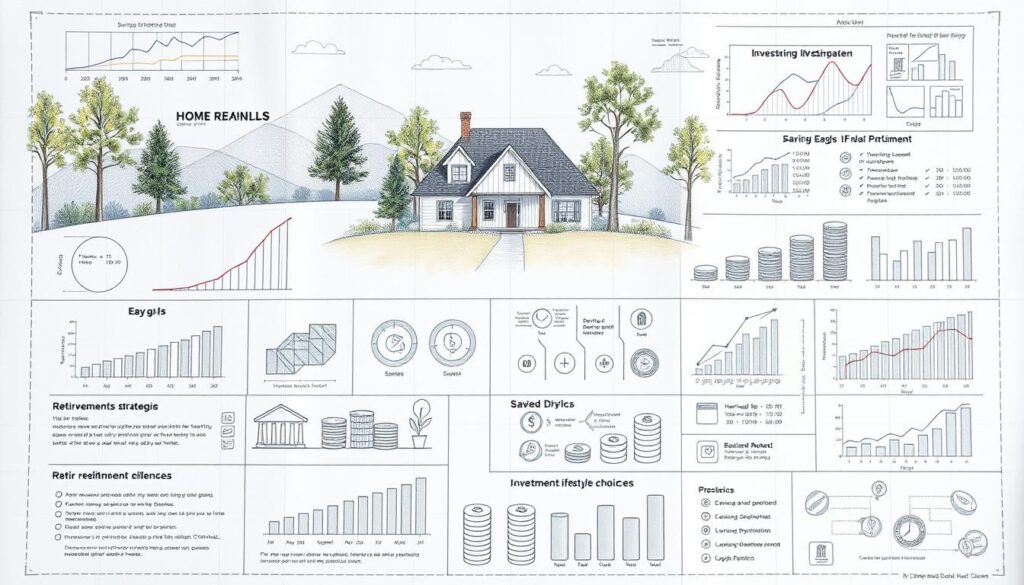Did you know about 30% of Americans might struggle financially when they retire? This is often due to not preparing well ahead. Yet, with the right plans, retiring early is totally doable. Experts who’ve worked in finance for years have managed to retire at 421. This piece aims to be your all-in-one guide to creating a sound retirement plan. It focuses on setting goals for retirement, building wealth, and ensuring financial security. We will break down the path into easy steps. You’ll learn how to picture your ideal retirement and use smart savings and investment moves. Our main aim is to help you take charge and confidently plan for a wealthy retirement.
Key Takeaways
- Retirement at an early age is achievable with proper planning and strategies.
- Visualizing your retirement goals is essential for successful financial planning.
- Understanding cash flow and liabilities plays a crucial role in financial health.
- Real estate investments can significantly contribute to wealth accumulation.
- Regular meetings with a financial advisor help keep you on track with your goals.
- Implementing lifestyle changes can aid in achieving early retirement.
Understanding the Importance of Retirement Planning
Planning for retirement is key to a stable financial future. It helps you figure out what you need for money and set goals for your future lifestyle. Many don’t save enough for the life they want in retirement, causing worry and uncertainty.
About 94% of retirees get money from Social Security, and 69% use their own savings. This shows why it’s crucial to start saving early and wisely2. If you’re saving in a 401(k) or IRA, knowing how much you can contribute is important. In 2024, you can put up to $23,000 in a 401(k), and there are extra options for those older3.
Being well-prepared makes retiring easier, letting you hit your financial targets. It’s important to begin planning soon or check on your current savings, especially as retirement gets closer. People born in 1960 or after can get full Social Security at 67, highlighting the need for early savings efforts4.
| Retirement Account Type | Annual Contribution Limit (2024) | Catch-up Contribution (Age 50+) |
|---|---|---|
| 401(k)/403(b) | $23,000 | $7,500 |
| Traditional IRA | $7,000 | $1,000 |
| Roth IRA | $7,000 | $1,000 |
| SIMPLE IRA | $16,000 | $3,500 |
Every dollar you save now builds your future financial strength. Aiming to replace 70% to 90% of your income before retirement through savings and Social Security is a good goal4. Starting a strong retirement plan today means secure living for your future.
The Reality of Retirement Savings in America
Many Americans face worrying facts about their retirement savings. 37% have little to no money saved for their later years. This highlights a real challenge as people try to secure their financial future5. Almost half, 46%, plan to work past 65. This shows a change in how people view retirement, relying less on employer benefits6.
Knowing how to manage retirement money is very important. Different retirement accounts offer various benefits. For example, IRAs can lower your taxes and let your money grow tax-free until you use it5. As we live longer, it’s vital to have enough saved up. This means planning carefully to make sure you don’t outlive your savings6.

Taking action early on savings is key. If you save 10% of a $50,000 income, you might need 51 years to retire7. But saving 15% could let you retire 8 years sooner7. Learning more about money can help you retire better and tackle the tough parts of saving for the future.
Step 1: Imagine Retirement
Start planning your retirement by imagining it vividly. Think about what you dream of doing and how these dreams fit with your life goals. Consider which activities would make you happy and fulfilled in retirement. Also, think about how you might contribute to community causes important to you.
Defining Your Retirement Aspirations
It’s important to set clear goals for a fulfilling retirement. Picture your everyday life, hobbies, and social life during retirement. Make a list of your aims, which could include:
- Traveling to new places
- Learning a new skill or hobby
- Volunteering for a local charity
- Keeping up with friends
Considering Family and Friends in Your Plans
Your retirement plans should also include your loved ones. Sharing your retirement with family and friends can make it better. Talk with them about what they look forward to doing together. Think about:
- Activities to enjoy with your family
- Ways to make memorable moments for your loved ones
- How family might help you during retirement
Evaluating Your Travel and Location Preferences
The place you choose to retire impacts your enjoyment. Think about if you prefer a quiet life in a small town or if you’d like to travel the world. Note down your preferences such as:
| Preference | Reasons |
|---|---|
| Cozy town | Peaceful environment, close family, relaxed lifestyle |
| Beachfront property | Access to nature, lively community, fun activities |
| Frequent travel | Discovering new things, learning about cultures, seeking adventures |
Building a detailed image of your retirement helps push your planning forward. Before looking at financial details, map out these elements. Each one greatly affects your happiness as you pursue a joyful retirement8.

Step 2: Take Inventory of Your Financial Situation
Getting a clear picture of your finances is crucial for planning your retirement. Checking your finances helps you see your income, savings, and spending. This lets you set achievable goals for the future. Start by carefully reviewing each part of your money matter to make a good budget plan.
Assessing Current Income and Savings
First, look at where your money comes from. Only a few Americans feel they have financial freedom9. Knowing the income after your expenses each month is key. This shows how much you can save for retirement. By putting away a bit regularly, like the average $272 credit card payment at 6% interest, in 20 years, you could have about $125,0009.
Identifying Monthly Expenses
After checking your income, figure out your monthly bills. Experts suggest saving 20% of what you earn9. Split your expenses into needs and wants to clear things up. Many believe being debt-free is key to financial freedom9. Yet, big credit card debts can block that path. The typical credit card debt is around $9,000, taking 53 months to clear, with about $6,000 going to interest9.
| Financial Metric | Statistic |
|---|---|
| Living Debt-Free | 54% of people associate it with financial freedom. |
| Average Credit Card Balance | Almost $9,000. |
| Average Duration to Pay Off Credit Card Debt | 53 months. |
| Interest Accumulated on Average Credit Card Debt | Nearly $6,000. |
| Amount to Save Monthly for Retirement | Approximately 20% of income. |

Step 3: Acknowledge Life Changes that Affect Retirement
Life changes can greatly shape your retirement planning. It’s important to look at all the factors that could change your future money situation. This includes thinking about health, possible job changes, and helping family out.
Healthcare Costs and Considerations
Healthcare becomes a big expense as you get older. Knowing what medical costs you might have helps you plan better. You need to think about insurance, direct costs, and care for later in life10.
Impacts of Career Decisions on Retirement
The choices you make in your career can change when and how you retire. Switching jobs or retiring early changes how much money you might make and save. When you retire affects your Social Security and pension, which are key to your money health10.
Family Support and Its Financial Implications
Thinking about if you need to help your family financially is also key. If your grown-up kids need help or you want to support relatives, it will impact how much you save. Knowing this helps you plan for surprises11.

| Life Change Factor | Description | Financial Impact |
|---|---|---|
| Healthcare Costs | Expenses related to medical needs, insurance, and long-term care. | Increases overall retirement expenses and savings requirements. |
| Career Decisions | Choices about job changes or retirement age. | Affects income levels and access to pension and Social Security benefits. |
| Family Support | Financial aid to adult children or relatives. | Reduces disposable income and savings potential. |
By considering these life changes in your retirement planning, you aim for a plan that fits you better. This way, you’re more ready for things that might happen unexpectedly3.
Step 4: Leverage Workplace Retirement Plans
Utilizing workplace retirement plans boosts your financial stability as you near retirement. Knowing the different options available lets you maximize your retirement contributions.
Maximizing Retirement Account Contributions
The max contribution to a 401(k) in 2023 is $22,500. Those aged 50 and over can add an extra $7,500. This allows you to grow your savings fast. If there’s a plan at work, join it. Taking full advantage of these benefits can greatly increase your retirement funds.
Understanding Employer Matching Contributions
Employer matching is key to enhancing your retirement savings. Contribute enough to get the full match, it’s like free money. It’s a fact that 401(k)s with employer matching can boost your savings. Using these matches helps ensure a stable financial future.
| Contribution Type | Maximum Contribution (2023) | Catch-Up Contribution (Ages 50+) |
|---|---|---|
| 401(k) | $22,500 | $7,500 |
| IRA | $6,500 | $1,000 |

Investing in various retirement accounts offers a diverse saving strategy. This provides more flexibility and potential gains. By using both a 401(k) and an IRA, you gain access to a wide range of investments and tax benefits1213.
Step 5: Setting Retirement Goals and Planning
It’s important to have a clear idea of what you want in retirement. You should set retirement goals that you can divide into small steps. One year, five years, and ten years targets help you stay focused. Retirement often starts after reaching a certain age or financial level, so planning is key14. Learning about various retirement tools, whether through work or on your own, is critical. This knowledge helps you choose the best options for your future.
Breaking Down Savings Targets by Timeline
Creating detailed savings goals makes it easier to achieve your retirement dreams. With people living longer, saving for 20-30 years of retirement is smart14. By aligning your savings with important life moments, you stay on track and motivated.
Education on Available Retirement Tools
Learning about the different retirement tools is vital. You might consider a 401(k) with employer match or an Individual Retirement Account (IRA)4. As retirement nears, shifting to safer investments is wise to protect your funds14. Advice from a financial advisor can also help tailor your plan, easing the switch to retirement.

Step 6: Want to Retire Rich? Here’s the Step-by-Step Blueprint You Need
To reach a rich retirement, you need careful planning and dedication. These five steps combine past talks on imagining your future, looking at your money, changing your life, using work benefits, and making goals. They form a clear plan for financial success. You build on each step, moving closer to your retirement dream.
The Five Steps to a Wealthy Retirement
- Define Your Retirement Expectations: Think clearly about what you want in retirement and how much money it will take.
- Assess Your Financial Situation: Look at what you earn, spend, and save. A stunning 77% of people lack a written plan for retiring, causing confusion and stress15.
- Utilize Employer-Sponsored Plans: Put as much as you can into your workplace retirement plans. It’s key to understand employer match benefits, which many miss out on, hurting their financial future.
- Set Concrete Retirement Goals: Make clear goals with a solid saving plan. Starting to plan is hard; 76% of people feel lost at first15.
- Implement Wealth Strategies: Use a mix of investments and know your risk level. As you get older, shift from gathering to keeping and giving out your wealth to protect it16.

If you follow these steps closely, you will lay a strong base for retirement. This plan not only boosts your money knowledge but also your confidence in handling retirement plans.
Step 7: Making Lifestyle Changes for Financial Success
Making intentional lifestyle changes is crucial for a secure future. Financial discipline helps you save more in the long run. By budgeting wisely, you free up money for your retirement, ensuring a wealthier tomorrow.
Living Below Your Means Now for a Richer Tomorrow
Cutting back on unnecessary costs can boost your financial health. Here are a few tips:
- Eliminate luxury items that contribute little to your well-being.
- Limit impulsive spending by waiting 24 hours before making non-essential purchases.
- Opt for economical alternatives in daily living, such as cooking at home instead of dining out.
17A study shows why changing our lifestyle matters. Only a little over half of adults have saved up three months’ emergency funds. This lack of readiness for financial setbacks is worrying. Additionally, the average American household is buried under $104,000 of debt. By focusing on paying off this debt while saving, you’ll fast-track your journey to financial freedom.
Thinking ahead is also key. One in four people in their twenties might face a disabling condition. This could keep them from working for a year or longer before they retire17. Making smart financial choices now will help you handle such unforeseen events and ensure a secure retirement.

Living within your means is very effective. It lets you save more now and builds a strong financial foundation for the future. Begin making these changes right away for lasting rewards18.
Step 8: Investing in Additional Income Streams
Looking for different ways to make money is key to growing your wealth. A smart move is to spread your investments beyond the usual choices. This ensures a safer future. Real estate is a good choice to mix things up in your investment plan.
Exploring Real Estate as an Investment Option
Real estate can help you make more money. It can bring in rent that helps you keep your lifestyle after you retire19. Owning properties can increase your monthly income and help you build up value over time.
Understanding the Importance of Diversification
Having a variety of investments can protect you from sudden market changes. Mixing in things like stocks, bonds, and real estate can help manage risk. The Living Wealthy System encourages setting up your savings to automatically invest in areas that bring in cash flow20. This way, you can work on making more money instead of just spending less.

| Investment Type | Potential Monthly Income | Risk Level |
|---|---|---|
| Real Estate (Rental) | $1,500 | Moderate |
| Stocks | $500 | High |
| Bonds | $300 | Low |
Understanding these different ways to make money can help secure your financial future. It also lets you enjoy spreading out your investments1920.
Step 9: Building a Transition Plan to Retirement
Getting ready for the shift to retirement is key. This is true if you plan to retire early. Putting a financial plan in place that includes a bridge account is smart. It gives you the needed funds as you get ready for this big change in life. A bridge account acts as a financial safety net until you can take money out from your retirement funds without a penalty.
This method can reduce the worry about money when retiring early.
Creating a Bridge Account for Early Retirement
Having a bridge account makes your move into retirement smoother. Many realize that health insurance for early retirees costs more compared to those with jobs. On average, these costs, along with other higher medical expenses, increase their financial load as they approach retirement21. This financial plan creates a backup to protect your money. Also, having extra ways to make money, like from renting property or working part-time, adds more security during this change21.
When setting up your bridge account, think about your monthly spending, expected income, and when you can access your retirement accounts without penalties. It’s a good move to have an emergency fund to cover six months of expenses in retirement22. This safety net can help you handle any unexpected events that come up.
Here’s a table to guide you in structuring your bridge account:
| Expense Category | Estimated Monthly Cost | Comments |
|---|---|---|
| Healthcare | $800 | Higher costs for early retirees |
| Housing | $1,500 | Mortgage or rent payments |
| Utilities | $300 | Electricity, water, etc. |
| Groceries | $400 | Based on dietary needs |
| Transportation | $250 | Car maintenance or public transport |
| Miscellaneous | $500 | Entertainment, personal care |

A bridge account is a key step in your retirement plan. It helps you stay financially stable as you enter this new chapter of your life23.
Step 10: Seeking Professional Financial Advice
It’s important to get help from a financial advisor for retirement planning. They offer detailed retirement guidance, which helps you make choices that suit your financial situation best.
The Role of a Financial Advisor in Retirement Planning
Talking to an expert can improve your grasp of market trends and tax effects. Also, it aids in enhancing your retirement planning. A surprising 56% of Americans aren’t sure how much to save for a comfortable retirement24. This fact underscores the value of having a financial advisor to create a solid plan.
Moreover, 37% of folks have hardly any retirement savings24. An advisor can review your finances and offer investment advice to fill any savings shortfall. Nearly 46% expect to work past age 65, highlighting the importance of careful planning24.
In 2023, you can put up to $22,500 into a 401(k) plan24. Advisors can show you how to fully utilize these accounts. People over 50 have the chance to add an extra $7,500, boosting their savings24. An advisor’s insights into these options are crucial for your retirement readiness.
Using resources from firms like Morgan Stanley can also help. They ensure you know and use the right tools to grow your retirement funds24. The best financial advisor provides continuous support, adjusting plans as your life evolves.

| Aspect | Without Advisor | With Advisor |
|---|---|---|
| Clarity on Savings Needs | 56% uncertain24 | High clarity |
| Retirement Savings | 37% with no savings24 | Increased savings |
| Future Work Plans | 46% plan to work past 6524 | Targeted strategies for retirement |
| 401(k) Contribution Knowledge | Low awareness | Maximized contributions |
Conclusion
In wrapping up this retirement planning summary, we see that a good plan is more than a list; it’s a commitment to your financial freedom. It’s key to know what you need and be ready to change with the times. This keeps you set for now and later. Many who just retired spend more than planned in the first two years. This shows why being realistic with your money planning is critical25.
Your path to retirement success starts with setting goals that you can actually reach. It turns out, only 8% of people stick to their New Year’s resolutions. This highlights how crucial it is to write down your goals and check on them often for success26. Keep in mind, being flexible with your goals helps you overcome obstacles, making sure your plan fits your dreams.
The way to get the retirement life you want involves smart choices, ongoing check-ins, and adjusting plans when needed. Start applying these planning tips now. Your future self will thank you for the effort you make today towards reaching your retirement goals.








